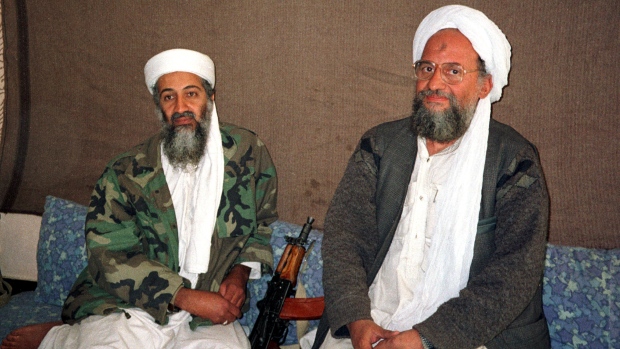The terror group Al Qaeda has survived the death of its founder Osama bin Laden on May 2, 2011 and bolstered its notoriety with attacks in Africa, Europe and Yemen despite suffering a series of setbacks.
Al Qaeda has been replaced as a pre-eminent global militant power by the powerful militant outfit Islamic State (ISIL) but nevertheless remains a potent force and a dangerous threat, experts say.
By the time US special forces killed bin Laden in Abbottabad, the group he founded in the late 1980s had been badly damaged, with many of its militants and leaders killed or captured in the US “War on Terror”.
Dissention grew in the militant ranks as new Qaeda chief Ayman al-Zawahiri struggled in bin Laden’s place, until one of its branches, originally Al Qaeda in Iraq, broke away to form the Islamic State of Iraq and the Levant (ISIL).
After seizing large parts of Iraq and Syria in 2014, the group declared a caliphate’ in areas under its control, calling itself simply the IS.
IS has since eclipsed its former partner, drawing thousands of militants to its cause and claiming responsibility for attacks that have left hundreds dead in Brussels, Paris, Tunisia, Turkey, Lebanon, Yemen, Saudi Arabia and on a Russian airliner over Egypt.
Its self-declared ’emir’ Abu Bakr al-Baghdadi has won pledges of allegiance from extremist groups across the Middle East and beyond, with especially powerful IS affiliates operating in Egypt’s Sinai Peninsula and in Libya.
Jean-Pierre Filiu, a Paris-based expert on Islam and jihadist groups, said IS has been especially effective at using new technology to surpass its less tech-savvy rival.
“Al Qaeda propaganda has become invisible on social networks thanks to the media war machine that Daesh has managed to successfully create,” Filiu said, using an Arabic acronym for IS.
“Al-Qaeda has lost everywhere to Daesh, except in the Sahel” desert region of northern Africa, he said.
Here are key dates in the group’s development since Egyptian Ayman al-Zawahiri succeeded bin Laden as Al Qaeda’s chief on June 16, 2011.
US ambassador killed in Benghazi
September 11, 2012, Libya:
An attack carried out in part by Al Qaeda militants against the US consulate in Benghazi, Libya, kills four Americans, including ambassador Chris Stevens.
Al Qaeda in the Arabian Peninsula (AQAP) calls for more attacks against US diplomatic missions in the Middle East and Africa, and urges Muslims living in the West to target US interests.
Violence that leaves more than 50 people dead sweeps across the Middle East amid protests against the anti-Islam film “Innocence of Muslims”, produced by a US religious group.
Deadly North African network
January 11, 2013:
France and its allies intervene in northern Mali, where Al Qaeda in the Islamic Maghreb has strongholds.
Five days later, an AQIM affiliate in the Sahara desert, Al-Murabitoun, attacks an Algerian natural gas complex at In Amenas, where 40 hostages and 29 attackers die.
The group’s leader, who is still at large, is Mokhtar Belmokhtar, a one-eyed militant dubbed “The Uncatchable” by French officials.
France expands its operations to include Burkina Faso, Chad, Mauritania and Niger, while AQIM militants stage attacks that kill dozens in Bamako, Ivory Coast and Ouagadougou.
France, India, Iraq and Syria
April 10, 2013, Syria:
The Al-Nusra Front pledges allegiance to Al Qaeda, becoming a bitter rival to former allies in Iraq that have formed the militant Islamic State (IS) group. Al-Nusra becomes a major force in the Syrian conflict.
June 29, 2014, Iraq:
The proclamation of an Islamic caliphate in Iraq and Syria by IS, formerly a branch of Al-Qaeda in Iraq, fuels growing tension between the groups.
In September, 2014, Zawahiri announces the creation of Al Qaeda in the Indian Subcontinent (AQIS).
January 7, 2015, France:
An attack on the satirical weekly Charlie Hebdo in Paris kills 12 people and is claimed by AQAP.
Yemen/Somalia
April 2, 2015, Yemen:
AQAP captures Mukalla, a provincial capital in southeastern Yemen, benefiting from chaos that reigned after a Saudi-led coalition launched air strikes against Houthi rebels in the country.
On March 22, 2016, however, a US air strike on an AQAP training camp in the region kills 71 recruits.
The US has also targeted Al Qaeda linked Shebab fighters in Somalia, with an air strike killing more than 150 in early March 2016. A Pentagon spokesman says they were “training for a large-scale attack”.
Holed up back home
August 13, 2015, Afghanistan and Pakistan:
Zawahiri pledges his group’s allegiance to new Taliban chief Mullah Akhtar Mansour, involved in a bitter leadership struggle.
Zawahiri is believed to be in hiding in the Pak-Afghan border region, where bin Laden was holed up after the 9/11 attacks.
‘Jihad will last decades’
The US still sees Al Qaeda as a key threat, pursuing a vigorous drone war against the group in Yemen.
The strikes have killed many senior operatives, including Al Qaeda’s second-in-command Nasir al-Wuhayshi in June 2015. In March a US strike on an AQAP training camp in Yemen killed at least 71 recruits.
Writing for French news website Atlantico in early April, former intelligence officer Alain Rodier said that while IS may have stolen the spotlight, Al Qaeda may be in a better long-term position.
By rushing to declare its caliphate and establish its rule, IS has made itself an easier target, with thousands of its supporters killed in air strikes launched by a US-led coalition and by Russia.
Its harsh rule has also alienated potential supporters, while groups like Al-Nusra have instead sought to work with local forces in areas under their control.
“The death of Al Qaeda’s founding father in no way meant the end of his progeny,” Rodier wrote. “This jihad will last for decades.”
Read : Osama Bin Laden wanted to exploit Indian threat to take over Pakistan






